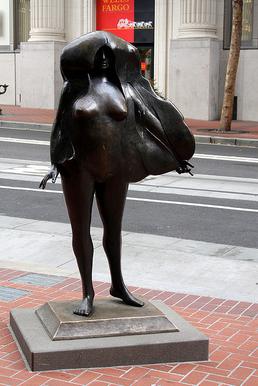
Kvinneakt is an abstract bronze sculpture located on the Transit Mall of downtown Portland, Oregon. Designed and created by Norman J. Taylor between 1973 and 1975, the work was funded by TriMet and the United States Department of Transportation and was installed on the Transit Mall in 1977. The following year Kvinneakt appeared in the "Expose Yourself to Art" poster which featured future Mayor of Portland Bud Clark flashing the sculpture. It remained in place until November 2006 when it was removed temporarily during renovation of the Transit Mall and the installation of the MAX Light Rail on the mall.

Pod is the name of a 2002 modern sculpture by American artist Pete Beeman, currently installed at Southwest 10th Avenue and West Burnside Street in downtown Portland, Oregon. The 30-foot (9.1 m) sculpture, intended to represent the "infrastructure, energy, and vibrancy of Portland," is supported by its static tripod base with a 15-foot (4.6 m) diameter. It is constructed from stainless steel, galvanized steel, bronze, titanium, lead and other materials. Pod was fabricated by Beeman and David Bermudez, and engineered by Beeman and Peterson Structural Engineers. It is considered interactive and kinetic, with a central, vertical pendulum that swings back and forth when pushed. The sculpture cost as much as $50,000 and was funded by the Portland Streetcar Project. Pod is part of the City of Portland and Multnomah County Public Art Collection courtesy of the Regional Arts & Culture Council.

Animals in Pools is a series of fountains and bronze sculptures of Pacific Northwest animals, designed by American artist Georgia Gerber and located in Portland, Oregon, in the United States. The series was installed in 1986 as part of the renovations associated with construction of the MAX Light Rail. Funded by the Downtown Merchants Local Improvement District, TriMet and the United States Department of Transportation, the sculptures were presented as gifts to the city and remain part of the collection of the City of Portland and Multnomah County Public Art Collection courtesy of the Regional Arts & Culture Council.

Thompson Elk Fountain, also known as the David P. Thompson Fountain, David P. Thompson Monument, Elk Fountain, the Thompson Elk, or simply Elk, is a historic fountain and bronze sculpture by American artist Roland Hinton Perry. The fountain with its statue was donated to the city of Portland, Oregon, United States, in 1900 for display in Downtown Portland's Plaza Blocks. It is owned by the City of Portland.
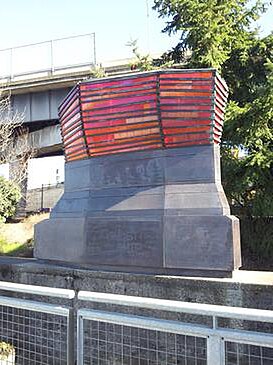
Ghost Ship is an outdoor 2001 sculpture by James Harrison and Rigga, a group of local artists, located along the Eastbank Esplanade in Portland, Oregon. It is made of copper, stainless steel, art glass, and two lamps. It is part of the City of Portland and Multnomah County Public Art Collection courtesy of the Regional Arts & Culture Council.

Talos No. 2 is an outdoor 1959–1977 bronze sculpture created by the American artist James Lee Hansen. It is located in the Transit Mall of downtown Portland, Oregon, in the United States.

Howard's Way is an outdoor 2007 art installation comprising four stainless steel sculptures by American artist Lee Kelly, located in downtown Portland, Oregon.

Driver's Seat is a 1994 galvanized steel sculpture by Don Merkt, installed along the Transit Mall in Portland, Oregon's Old Town Chinatown neighborhood, in the United States. The artwork was funded by the City of Portland's Percent for Art program, the Portland Development Commission, and TriMet, and remains part of the City of Portland and Multnomah County Public Art Collection courtesy of the Regional Arts & Culture Council.

Vera Katz, also known as Mayor, Vera Katz, is an outdoor bronze sculpture depicting Vera Katz created by American artist Bill Bane. Unveiled in 2006, it is located along the Eastbank Esplanade in Portland, Oregon. Katz, a former mayor of the city between 1993 and 2005, supported arts and culture during her tenure and established Oregon's Percent for Art program. She was also instrumental in developing the Eastbank Esplanade, which is named after her. The sculpture has received a mostly positive reception and has inspired people to adorn it with clothing, flowers and makeup.

In the Shadow of the Elm is an outdoor 1984 sculpture by Paul Sutinen, located at the South Park Blocks in Portland, Oregon.

City Reflections is an outdoor 2009 bronze sculpture by Patti Warashina, located in downtown Portland, Oregon.

Chinatown Gateway is an outdoor paifang and sculpture which serves as an entrance to Portland, Oregon's Old Town Chinatown neighborhood, in the United States. The gate was proposed by the Chinese Consolidated Benevolent Association in 1984. Architect Yu Tang Wang and artist Sun Chau completed the gate's design, which was built by Ting Hwa Architects in Taiwan. It was then shipped to Portland and installed in one week before being dedicated in November 1986. It cost $256,000 and was the largest of its kind in the United States until one in Washington, D.C. was completed several months later.
Dan Corson is an artist living in Hawaii and is a former member of the Seattle Arts Commission. He works in the field of public art, creating large-scale, concept-driven works installed in urban environments including in parks, railway stations, art galleries, meditation chambers, at intersections, under freeways, and on sidewalks. His approach is a mixture of sculpture, installation, theatrical design, architecture, and landscape design. Media include metal, glass, concrete, fiberglass, gravel, LEDs, lasers, neon, solar panels, radar detectors, photo-voltaic cells, infrared cameras, motors, searchlights, and occasionally elements such as fire, water, and smoke. His work frequently incorporates cutting-edge technology in lighting, sound, and other electronic media.

Leland I, sometimes stylized as Leland 1 or Leland #1, is an outdoor 1975 sculpture by Lee Kelly and Bonnie Bronson, installed in Portland, Oregon, United States.

Festival Lanterns is an outdoor 2006 art installation consisting of granite and steel sculptures by American artist Brian Goldbloom, installed in northwest Portland, Oregon, in the United States. The work is administered by the Regional Arts & Culture Council.
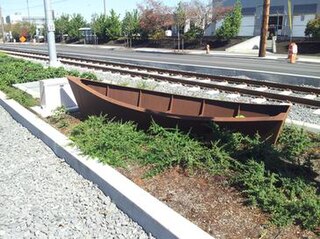
Passage is an outdoor 2014 art installation consisting of 38 weathered steel boat sculptures by Bill Will, installed along the MAX Orange Line in the Brooklyn neighborhood of southeast Portland, Oregon, in the United States.
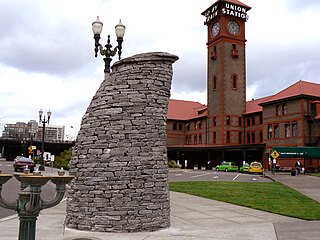
Cairns is an outdoor 2008 public art installation by American artist Christine Bourdette, installed in the Old Town Chinatown neighborhood of Portland, Oregon, in the United States.
Silicon Forest, sometimes referred to as The Silicon Forest, is an outdoor 2003 sculpture by Brian Borrello, installed near the Interstate/Rose Quarter station in Portland, Oregon's Lloyd District, in the United States.
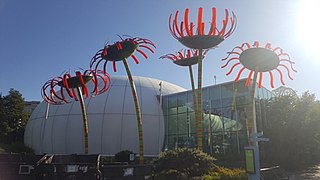
Sonic Bloom is a 2013 solar-powered sculpture by Dan Corson, installed in Seattle's Pacific Science Center, in the U.S. state of Washington. Bellamy Pailthorp wrote, "It looks a bit like something you might find in a book by Dr. Seuss: five huge sculpted sunflowers with striped green and orange stems."



















